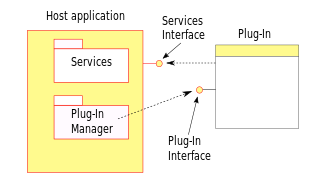Plug-in (computing)
This article needs additional citations for verification. (September 2019) |
In
A
Purpose and examples
Applications may support plug-ins to:
- enable third-party developersto extend an application
- support easily adding new features
- reduce the size of an application by not loading unused features
- separate source code from an application because of incompatible software licenses.
Types of applications and why they use plug-ins:
- are examples of such systems.
- Email clients use plug-ins to decrypt and encrypt email. Pretty Good Privacy is an example of such plug-ins.
- Video game console emulators often use plug-ins to modularize the separate subsystems of the devices they seek to emulate.[2][3][4][5][6][7][8][9][10] For example, the PCSX2 emulator makes use of video, audio, optical, etc. plug-ins for those respective components of the PlayStation 2.
- Photoshop plug-inmay do this.
- are examples of such media players.
- Packet sniffers use plug-ins to decode packet formats. OmniPeekis an example of such packet sniffers.
- Opticks.
- Eclipse, IntelliJ IDEA, jEdit and MonoDevelop support plug-ins. Visual Studio itself can be plugged into other applications via Visual Studio Tools for Office and Visual Studio Tools for Applications.
- , which are a separate type of installable module, are still widely in use.)
Mechanism

The host application provides services which the plug-in can use, including a way for plug-ins to register themselves with the host application and a
Programmers typically implement plug-ins as
.Mozilla definition
In
Helper application
A helper application is an external viewer program—like
History
In the mid-1970s, the EDT text editor ran on the Unisys VS/9 operating system for the UNIVAC Series 90 mainframe computer. It allowed a program to be run from the editor which can access the in-memory edit buffer.[22] The plug-in executable could call the editor to inspect and change the text. The University of Waterloo Fortran compiler used this to allow interactive compilation of Fortran programs.
Early personal computer software with plug-in capability included HyperCard and
See also
References
- ^ Sterne, Jonathan. "Plug-in | software". Encyclopedia Britannica. Retrieved 2021-02-05.
- ^ "PCSX2 - The Playstation 2 emulator - Plugins". pcsx2.net. Retrieved 2018-06-10.
- ^ Bernert, Pete. "Pete's PSX GPU plugins". www.pbernert.com. Retrieved 2018-06-10.
- ^ Team, Demul. "DEMUL - Sega Dreamcast Emulator for Windows". demul.emulation64.com. Retrieved 2018-06-10.
- ^ "Android Emulator Plugin - Jenkins - Jenkins Wiki". wiki.jenkins.io. Retrieved 2018-06-10.
- ^ "KDE/dolphin-plugins". GitHub. Retrieved 2018-06-10.
- ^ "OpenEmu/SNES9x-Core". GitHub. Retrieved 2018-06-10.
- ^ "Recommended N64 Plugins". Emulation General Wiki. Retrieved 2018-06-10.
- ^ "Playstation plugins & utilities!". www.emulator-zone.com. Retrieved 2018-06-10.
- ^ "PS3 Homebrew Apps / Plugins / Emulators | PSX-Place". www.psx-place.com. Retrieved 2018-06-10.
- ^ Mozilla Firefox plugins – Description of the difference between Mozilla Firefox plugins and extensions under the general term add-on.
- ^ Wordpress Plug-in API – Description of the Wordpress Plug-in architecture.
- ^ "Plugin". developer.mozilla.org. Retrieved 2022-12-07.
- ^ Paul, Ian. "Firefox will stop supporting plugins by end of 2016, following Chrome's lead". PCWorld. IDG. Retrieved 20 October 2016.
- ^ "Pale Moon: Technical Details - Features". Pale Moon. Retrieved 2020-06-06.
- ^ "Basilisk: Features". Basilisk. Retrieved 2020-06-06.
- ^ "Re: Remember: Plugins are outdated". Pale Moon Forums. Retrieved 2020-06-06.
- ^ "Definition of helper application". PCMAG. Retrieved 2022-10-25.
- ^ "Download Irfan using Internet Explorer 4.x or above". libweb.hawaii.edu. Retrieved 9 January 2024.
- ^ "Helper Applications and Plug-ins - Web Security, Privacy & Commerce, 2nd Edition [Book]". Web Security, Privacy, and Commerce 2nd Edition. O'Reilly.
- ^ "For web browsers, what are helper applications, and where can I find them?". kb.iu.edu.
- Unisys Corporation, 1975
